The Qualcomm Snapdragon 835 Performance Preview
by Matt Humrick & Ryan Smith on March 22, 2017 4:30 AM EST- Posted in
- Smartphones
- Snapdragon
- Qualcomm
- Mobile
- SoCs
- Snapdragon 835
- Kryo
GPU Performance
Snapdragon 835’s updated Adreno 540 GPU shares the same basic architecture as Snapdragon 820’s Adreno 530, but receives some optimizations to remove bottlenecks along with some tweaks to its ALUs and register file. The Adreno 540 also reduces the amount of work done per pixel by using improved depth rejection, which could further improve performance and reduce power consumption.
Qualcomm is claiming a general 25% increase in 3D rendering performance relative to the Adreno 530 in S820. While not officially confirmed, it appears that Qualcomm is using the move to 10nm to increase peak GPU frequency to 710MHz, a roughly 14% increase over S820’s peak operating point, which would account for a significant chunk of the claimed performance boost.
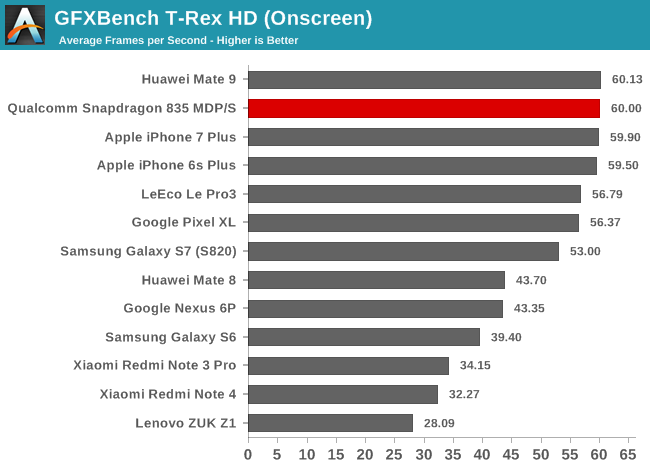
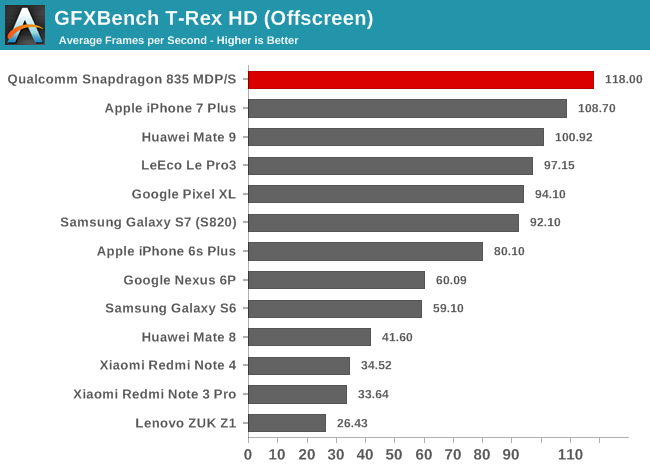
GFXBench T-Rex is an older OpenGL ES 2.0-based game simulation that’s not strictly limited by shader performance like the newer tests, which is one reason why flagship phones have been hitting the 60fps V-Sync limit for awhile now in the onscreen portion of the test. More recently, we’ve seen the iPhone 7 Plus and Mate 9, which both have 1080p displays, average 60fps over the duration of the test. Now the Snapdragon 835 MDP/S becomes the first 1440p device to reach this milestone.
The Snapdragon 835 MDP/S outperforms the iPhone 7 Plus and Mate 9 when running offscreen at a fixed 1080p resolution. It’s also 25% faster than the Pixel XL, the highest performing Snapdragon 820 phone, exactly matching Qualcomm’s performance claim. Sliding a little further back along Adreno’s roadmap shows the Adreno 540 with almost a 2x advantage over the Nexus 6P’s Adreno 430 and a 4.5x advantage over the ZUK Z1’s Adreno 330.
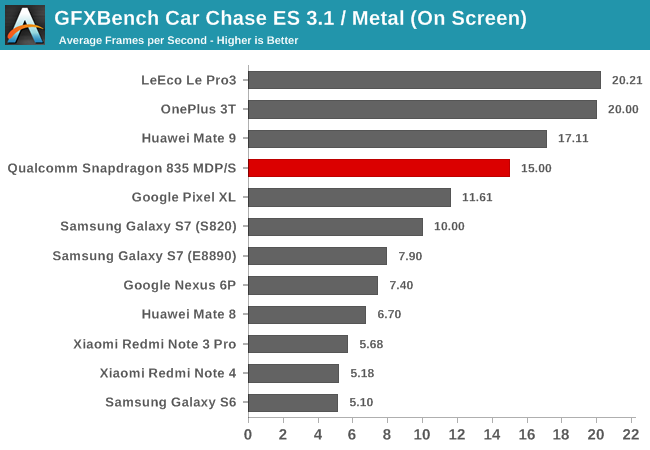
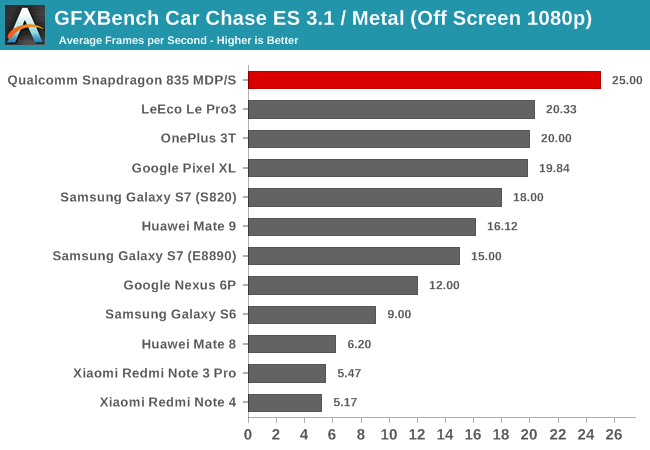
The GFXBench Car Chase game simulation uses a modern rendering pipeline with the latest features found in OpenGL ES 3.1 plus Android Extension Pack (AEP), including tessellation. Like many current games, it stresses ALU performance to deliver advanced effects.
Lower resolution 1080p displays paired with modern GPUs elevate the LeEco Le Pro3 (S821), OnePlus 3T (S820), and Huawei Mate 9 (Kirin 960) to the top of the chart in the onscreen portion of the test. The Snapdragon 835 MDP/S is the fastest 1440p device, besting the second-place Pixel XL by 29%.
Moving to the offscreen test shows the Adreno 540 GPU with a 25% lead over the Adreno 530 in S820. I do not usually put too much stock in performance claims on marketing slides, but so far Qualcomm’s claim is surprisingly accurate. Even more impressive is its 55% lead over the Mate 9’s Mali-G71MP8 GPU, which is based on ARM’s latest Bifrost microarchitecture and is running at 960MHz to 1037MHz during this test.
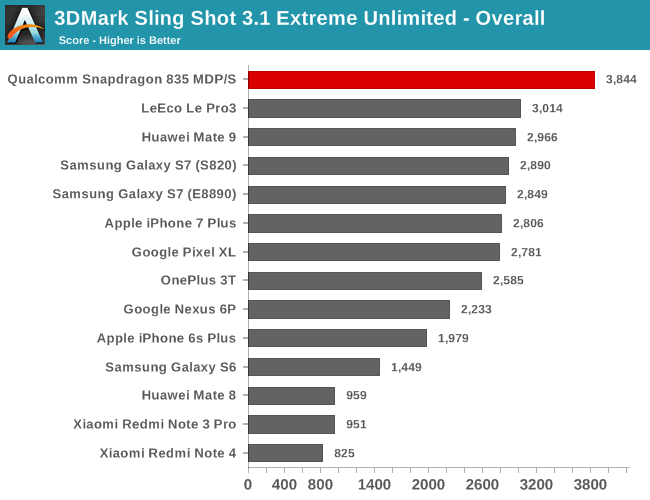


3DMark Sling Shot Extreme uses either OpenGL ES 3.1 on Android or Metal on iOS and stresses the GPU and memory system by rendering offscreen at 1440p (instead of 1080p like our other tests).
The Snapdragon 835’s 30% better overall score is pretty significant, considering that there’s only an 8% difference between all the phones using the Apple A10, Exynos 8890, Kirin 960, and S820/S821 SoCs. Diving into the graphics segment shows the Snapdragon 835 MDP/S outperforming the iPhone 7 Plus by 10% and both the S820 and Exynos 8890 versions of the Galaxy S7 by 24%.
Unlike the Adreno 530, which saw a significant uplift in geometry processing from changes to its microarchitecture, it does not appear that any additional changes were made to Adreno 540 based on its similar performance in 3DMark Sling Shot’s first graphics test. ARM’s Mali GPUs have done comparatively well in geometry processing tasks in the past, and in the first graphics test the Adreno 540 is only 11% faster than the Mate 9’s Mali-G71 GPU.
It’s in the second graphics test, which emphasizes shader performance, where we see the biggest gains from Adreno 540, with a 34% lead over the Galaxy S7’s Adreno 530 and a 50% lead over the Mate 9’s Mali-G71. Qualcomm’s changes to its ALUs and register file seem to pay dividends here.
The Physics test runs on the CPU and is heavily influenced by how well an SoC’s memory controllers handle random access patterns. The Snapdragon 835 MDP/S finishes ahead of the Mate 9 by 14% despite their similar CPU performance. The S835’s memory controllers deliver lower latency and higher bandwidth than Kirin 960’s, which could explain its better result in this test.
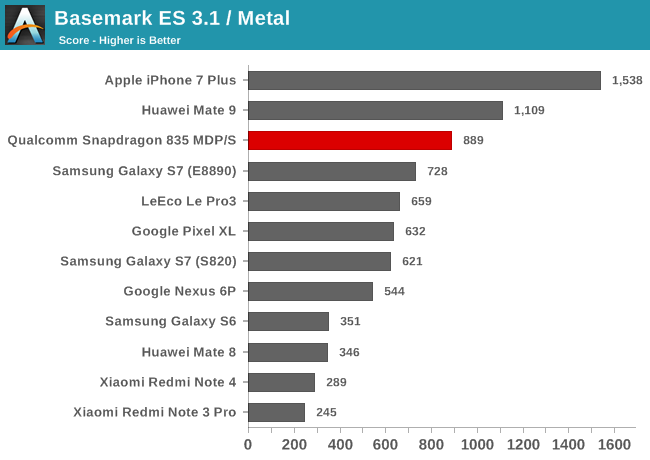
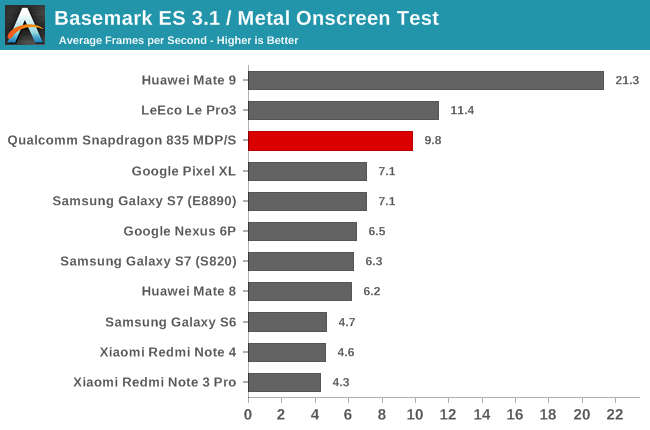

The Basemark ES 3.1 game simulation uses either OpenGL ES 3.1 on Android or Metal on iOS. It includes a number of post-processing, particle, and lighting effects, but does not include tessellation like GFXBench 4.0 Car Chase.
Until Vulkan support is added to benchmarks later this year, Android devices will continue to rely on OpenGL, putting them at a huge disadvantage to iPhones running Apple’s Metal graphics API, which dramatically reduces driver overhead when issuing draw calls. In this particular test, Metal helps push the iPhone 7 Plus in front of the Snapdragon 835 MDP/S by 73%.
ARM’s Mali GPUs perform better than their Adreno counterparts when running Basemark ES 3.1’s workloads; the Exynos 8890’s Mali-T880MP12 is 15% faster than S820’s Adreno 530 and Kirin 960’s Mali-G71MP8 is 25% faster than S835’s Adreno 540 in the offscreen test. The Snapdragon 835 MDP/S does perform 40% faster than the S820 in the Pixel XL, which is quite a bit more than the 25% gain it sees in our other tests.

The common theme in all of the game simulation tests is the Adreno 540’s better ALU performance, so I thought it would be interesting to see how well it performs in GFXBench’s synthetic ALU test. Surprisingly, its microarchitecture improvements are of no help here. The S835’s 14% advantage over the S820 and 8% advantage over the S821 exactly mirror their differences GPU frequency, assuming 710MHz for S835, suggesting this workload is bottlenecked elsewhere. It still manages to outperform the Mate 9’s Kirin 960 by 32%, however.










128 Comments
View All Comments
joms_us - Thursday, March 23, 2017 - link
Well not quite 100% to me... Hell knows what background app is making those spikes and not Geekbenchhttp://i.imgur.com/IjBdsOHh.jpg
http://i.imgur.com/6FWmG5Jh.jpg
http://i.imgur.com/IjMsOjIh.jpg
Remember the news about benchmark cheating of Samsung and now Oneplus? What they did are perfectly valid because a worthless app like Geekbench does not measure the true IPC of the SoC if it can't maximize it. You go to Windows world, people will disable CnQ or Speedstep and Powernow just to make sure processor is running at 100% of frequency to measure true IPC.
P.S Thanks for the name of the app, I appreciate it!
realbabilu - Sunday, March 26, 2017 - link
I remember in Windows Pc,is hard to get all cores stay flat at 100% unless I got very good multithread multiprocessor designed program like Ansys or Abaqus. Means its very tough to get/program a software that can utilize all cores stay at 100%.
ah06 - Wednesday, March 22, 2017 - link
Please stop posting, your understanding of SoCs is less than primary school level and you are talking to experts like Andrei........ah06 - Wednesday, March 22, 2017 - link
Why are you on Anandtech? How old are you?Please do not post again
joms_us - Thursday, March 23, 2017 - link
Oh some God from heaven, sorry for stopping by here.lilmoe - Thursday, March 23, 2017 - link
lol, I was literally being sarcastic in my comment. Looks like it stirred a lot of angry replies.- Geekbench does scale well across all cores. That's not the problem. Geekbench sucks as a benchmark for "absolute" performance of the CPU portion of an SoC (or platform like QC likes to call it) that matters for modern workloads. In addition to that, the way it calculates the totals and how the devs decide what sub-score counts more than what is absolute BS. Most of the workloads it tests are rarely dealt with the CPU and more commonly offloaded to co-processors. Yes, even on iOS devices. I find the compute portion of geekbench rather interesting, but it's rarely discussed by anyone.
- CPUs are getting less and less relevant in modern content consumption workloads. Offloading to co-processors, if at all possible, is the way to go. For instance, Intel's latest 7700K CPU (cpu only) pales in comparison to the least efficient 4K encoding/decoding block implementation on any modern platform, including ARM based SoCs. The same goes for image processing/manipulation, audio, speech recognition, security, etc, etc.... You know, the sub-tests that Geekbench performs.
- Interconnect, bandwidth, cache throughput and latency, and Scheduling play a huge part in the multi-core score of a CPU/SoC. Generally, the more cores you have, the harder and more power consuming it is to scale multiple threads across those cores, _especially_ on processors constrained with a 2-4 watt power envelope. Those caches are very power hungry and often limit scaling by 10-20% of ST even on non-power limited CPUs. That percentage is much, MUCH higher on ultra mobile ARM parts.
- In addition to those scaling issues, the Snapdragon 835, similar to Samsung's Exynos and HiSilcon's Kirin SoCs are big.LITTLE multi-cluster configurations. Typically, only 1 of these clusters is high performance, and only when you're running a single or couple of threads would the high performance cores reach their highest clocks. That's by design of ultra-low power, passively cooled parts. The Exynos 8890 gets up to 2.6Ghz in ST and 2.2Ghz in MT. Again, in addition to clock variance, you'll never get 8x ST since only 4 of those 8 cores are high performance. The smaller cores are nowhere near as powerful. I say they would count as Intel's virtual threads in their hyper threading (SMT), and should help to achieve better scaling by just a tiny bit.
So, yea. I was being sarcastic. I agree with Qualcomm. These modern ARM SoCs are very sophisticated and tricky to benchmark. Nothing about them is simple. What ultimately matters is how much time it takes them to complete a modern workload, and how much power they consume at that. The more of these workloads are offloaded to co-processors, the better.
For the CPU portion, what matters in a smartphone/tablet, first and foremost, is multi-core performance, and how much of that performance is sustained over time with the least amount of power consumption. ST performance is overrated doesn't matter, AT ALL, after a certain performance threshold IN MOBILE DEVICES. Split second javascript gains as a result of browser optimization or real ST lead of a particular SoC are irrelevant. Javascript doesn't exist in a vacume, it's part of a web page/app, and how long it takes a browser to fully load a page and render its content is what ultimately matters. Period.
tuxRoller - Thursday, March 23, 2017 - link
"I find the compute portion of geekbench rather interesting, but it's rarely discussed by anyone."Why is that the case?
Btw, this is a much better comment.
What you are saying is why relevant benchmarks don't exist for mobile devices (sub-laptops).
The issue, i believe, is that sites, largely, test these devices like small computers (bear with me). As such, they focus on cpu related tasks. Some sites include video recording/playback power usage, but none, tmk, include task traces that are taken from someone actually using a device.
tuxRoller - Wednesday, March 22, 2017 - link
If all you care about is a running a headless server that can't communicate with the outside world, then, yeah!If you care about battery life and good performance, low power processors (microcontrollers or tiny a series cores used for handling interrupts or more general duties when in a low power state), dsps and gpus matter.
Do we need a hashtag?
prisonerX - Wednesday, March 22, 2017 - link
Yeah those graphics co-processors, what a joke.wardrive2017 - Wednesday, March 22, 2017 - link
Again I am impressed by the Snapdragon 625 showing here in the cpu tests, particulary in the PC mark tests, not so much in the Javascript. Still performing much better than expected. The G5 plus is starting to look quite appealing assuming its tweaked the same ways the Moto z play is